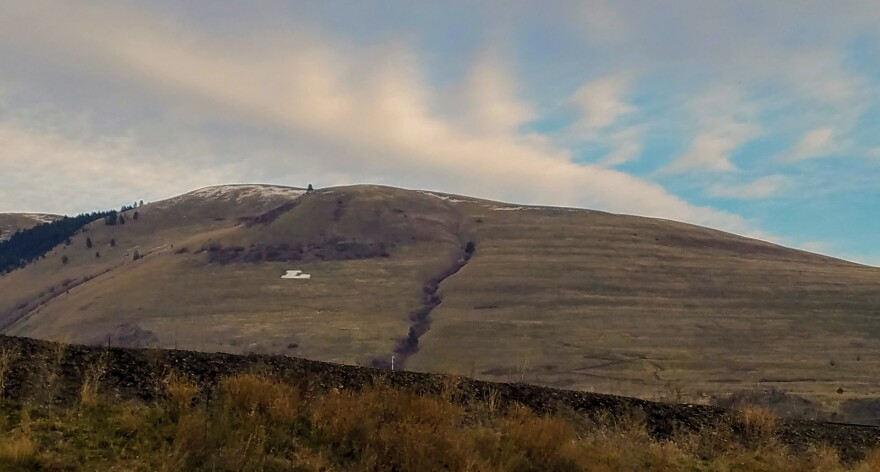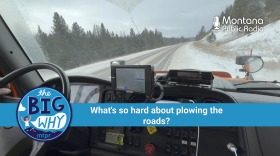Austin Amestoy: Welcome to the Big Why, a series from Montana Public Radio where we find out what we can discover together. I'm your host, Austin Amestoy. This is a show about listener-powered reporting. We'll answer questions, big or small, about anything under the Big Sky. By Montanans for Montana, this is The Big Why.
And joining us this week is MTPR's Victoria Traxler. Hey, Victoria.
Victoria Traxler Hey, Austin. Thanks so much for having me.
Austin Amestoy So what question are we diving into this week?
Victoria Traxler So you might have heard about the glaciers in Glacier National Park. In the mid 1800s there were about 80 of them, but today there's about 25 left. In fact, there are glaciers all over the mountains of Montana, and many of them are on the decline. A listener wanted to know about some very particular glaciers. They were curious about how glaciers are faring in the south end of the Mission Mountains, those big peaks you can see from Highway 93 on the Flathead Reservation.
Austin Amestoy Well, I've definitely heard about the glaciers in Glacier, but the ones in the Mission Mountains are news to me. But it was so hot this summer, Victoria, are there even any glaciers left up in the missions?
Victoria Traxler So before we get to that, I want to take a detour here to talk about the mountains, because from what I've learned researching this question, they were witnesses to quite a few dramatic changes in the landscape over the years.
Austin Amestoy Oh, dramatic. Well, roll back the clock for us, Victoria.
Victoria Traxler So going back about 2 million years, it was the Pleistocene Ice Age and ice was a defining feature of the continent. But in reality it ebbed and flowed, marched forward and retreated. About 15,000 years ago, the last bit of ice made its forward march. It dipped down into the Idaho Panhandle and blocked to the mouth of the Clark Fork River.
Washington State University video It created an ice dam half a mile high and as water backed up into the deep mountain valleys of western Montana, it began to form an enormous lake.

Victoria Traxler The enormous lake the narrator of this Washington State University video is describing became Glacial Lake Missoula. It filled hundreds of miles of territory, including the Flathead Valley, bordered by the Mission Mountains. And at the same time that this ice sheet was receding, it's very likely people were living among it. The Mission mountains are part of the Aboriginal territory of the Confederated Salish and Kootenai Tribes (CSKT). Here's hydrologist for the CSKT Natural Resources Department and tribal member Casey Ryan.
Casey Ryan So, our tribes have stories that talk about, a long time ago, when there were year-round snow and ice conditions, the same conditions that would have been present during the last ice Age between 10 [thousand] and 15,000 years ago.
Victoria Traxler This area is actually so important to their tribal culture it spurred the creation of the first tribally designated wilderness area in the country, the Mission Mountain Wilderness, back in 1982.
Austin Amestoy Right. I've heard of that before. It's pretty big, right?
Victoria Traxler Yep. Like 90,000 acres. Ryan told me that the legacy of ice and glaciers on the landscape in that wilderness is prevalent and powerful.
Casey Ryan To me, whether or not there are glaciers in the Mission Mountain that are still active in a scientific sense, I think glaciers are a very important part of the story of the Mission Mountains. And as I look at them right now as we're speaking, I am really grateful that our tribes have chosen to protect that area so that this is a place that people can continue to enjoy and appreciate for many generations to come.
Austin Amestoy Got it. So what's all that ice up to today?
Victoria Traxler Well, Geomorphologist and University of Montana professor Rick Graetz has a lot of ideas about that. He sometimes visualizes what the Missions would have looked like covered in ice sheets so many thousands of years ago.
Rick Graetz The southern end we're talking about now, the only thing showing was the highest peaks. The midrange was buried in it.
Victoria Traxler The summits you can see today — McDonald, St Mary's, Grey Wolf — would have been the only things visible above the blanket of white. He grew up staring at those snowcapped peaks, and as he got older, he hiked and climbed in the mountains. And eventually he also began to shoot aerial photos of the area to document changes in the glaciers there.
Rick Graetz We knew they were shrinking. We just wanted to record it.
Austin Amestoy So after spending so much time up there, how many glaciers does Graetz think are left?
Victoria Traxler His estimate is two: McDonald Glacier and maybe one behind Glacier Peak, if these past few months of summer didn't finish that one off. When I asked him how this made him feel, he said, It's sad.
Rick Graetz Yeah, that's the way it is. It's an altering climate that we're causing is going to get rid of the glaciers.
Austin Amestoy So what I'm hearing is there might be a couple of glaciers left in the Missions, but it's likely they won't last long. Is that right?
Victoria Traxler Yes. Graetz is actually planning another trip this fall just to see how much those remaining glacier have receded since he was last out there in 2016. The point is, there's uncertainty. But what's clear is that there are fewer glaciers in the Missions than there used to be, and they're fading fast.
Austin Amestoy And that sounds like it would make big changes to the landscape, Victoria. What would that mean for the Missions ecologically?
Victoria Traxler Well, a glacier is basically a river of ice formed when fallen snow compresses into ice over long periods of time. U.S. Geological Survey glaciologist Caitlyn Florentine told me glacial disappearance isn't a straightforward process either.
Caitlyn Florentine It's not like an extinction event or just like a light switch flipping on or off. Like, there are these gradation all processes, a continuum of processes happening on the landscape as the climate is changing.
Victoria Traxler Glaciers have been around for millennia. According to the USGS, glacial melt contributes water to the ecosystem during dry months. Those streams that run off during the summer create habitats for specific plants and animals. So those habitats, which are thousands of years old, change as glaciers disappear.
Austin Amestoy So the glaciers in the Missions are likely declining. We talked about the glaciers in the national park earlier. I'm imagining this isn't a phenomenon unique to Montana.
Victoria Traxler Definitely not. To put this all in a bigger picture, a study on the 200,000 some glaciers around the world found that between 2000 and 2019, glaciers collectively lost around 267 billion tons of ice every year. So glaciers everywhere are disappearing.
Austin Amestoy Wow, That's such a shame. How do people who have lived with these mountains feel about the dwindling ice and the missions?
Victoria Traxler Yeah. So I spoke with Germain White, a tribal member and former information and education program director for the tribe's Fish and Wildlife Division. She lives near the toe of the missions today.
Germain White I'm deeply moved by the rapid, dramatic changes in the glaciers.
Victoria Traxler For White, the visible loss of ice is hard, knowing it's connected to human-caused climate changes.
Germain White It's foreboding. You know, it's like when you see something that's moving in the wrong direction, you want to reach out and pull it back and say, 'oh, please move, move in this direction.'
Austin Amestoy Yeah. All the impacts of climate change, including declining glaciers, it can feel pretty gloomy.
Victoria Traxler But White did say she's encouraged by what's happening on the ground here in Montana.
Germain White I want to say how courageous I think the young people are for stepping forward and saying, you know, we have to stop climate change. We have a right to a healthy environment.
Austin Amestoy Right. We covered the Held vs Montana case where the judge ruled that the state's fossil fuel policies violate a constitutional right to a clean and healthful environment.
Victoria Traxler Exactly. Her point is, we may not be able to bring those glaciers in the Missions back, but that doesn't mean we can't make meaningful progress on combating climate change.
Austin Amestoy Well, Victoria, it's great to have you back on the show. Thanks for coming and sharing your reporting.
Victoria Traxler Yeah, thanks so much for having me.
Austin Amestoy: Now we want to know what makes you curious about Montana. Submit your questions below. Find us wherever you listen to podcasts and help others find the show by sharing it and leaving a review. Lets see what we can discover together!
-
If you’ve been to a taproom, you know that at most breweries across the state there’s a three pint limit and they stop serving at 8 p.m. One listener wants to know why. We've got answers. Pull up a stool, crack open a local brew and settle in for a taproom tale – or some barroom banter, depending on the time of day.
-
When it comes to winter driving, everyone wants their route clear and dry, and they want it done quickly. Why don't the plows come sooner or more often? Why don't they drop more salt or deicer? Why not get more drivers on the road? Tag along as a Montana snowplow driver prepares for a big winter storm and find out more about the logistical, environmental and technical challenges that come with keeping the roads clear of snow.
-
How do cabbage and spices become ingredients for community building? In Korea, the answer is kimjang, the fall tradition of making and sharing kimchi. This week on The Big Why, we visit a farm in the Bitterroot Valley where a group of Montanans came together to keep a food custom alive and find comfort and connection among the cabbage.
-
In Montana, abortion access has been at times illegal, legal, and stuck in limbo. Providers have weathered bombings and arson, advocates and opponents have battled it out in court, and citizens have passed a constitutional amendment affirming a woman's right to choose. One listener wants to know more about the history of reproductive rights in Montana. MTPR's Aaron Bolton reports on the underground networks, political violence and landmark court cases that got us to where we are today.









